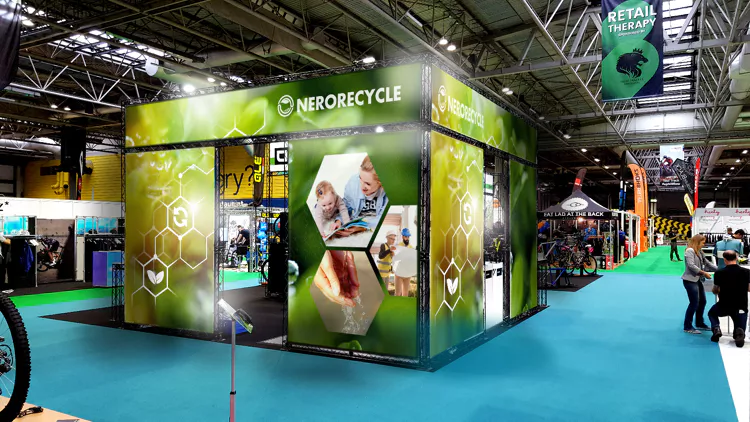Embracing Eco-Friendly Communication
Defining Sustainable Signage
Sustainable signage represents an eco-conscious approach, utilizing materials and practices that minimize environmental impact. It’s a commitment to longevity, recyclability, and energy efficiency. As experts in digital sign installation, we recognize the power of signs that speak volumes, not only with words but also through their sustainable footprint.

The Imperative of Sustainability
In the bustling restaurant industry, sustainability is no longer a choice; it’s an imperative. Patrons are increasingly eco-aware, seeking establishments that align with their values. Sustainable signage is a visible testament to a restaurant’s dedication to environmental stewardship, enhancing brand image and customer loyalty.
QR Codes: A Digital Leap Forward
QR code integration stands at the forefront of sustainable practices. By replacing traditional menus and promotional materials with a simple scan, restaurants drastically reduce paper waste. This seamless fusion of technology and sustainability not only conserves resources but also enriches the customer experience with the touch of innovation.
The Environmental Impact of Traditional Signage
Materials in Conventional Signage
Traditional signage often relies on plastics, metals, and non-recyclable composites. These materials, while durable, pose significant environmental challenges. They require energy-intensive processes to produce and are not easily decomposed, leading to long-term ecological footprints.
Disposable Menus: A Wasteful Norm
Single-use menus contribute to a staggering amount of waste. Restaurants frequently discard these paper products, creating a cycle of consumption and waste that burdens landfills and strains recycling systems. The ephemeral nature of these items belies their lasting environmental impact.
Energy Costs of Paper Menus
The lifecycle of a paper menu—from production to disposal—demands substantial energy. Harvesting trees, processing pulp, and printing menus consume resources and emit greenhouse gases. When these menus are discarded, additional energy is expended in waste management, compounding their carbon footprint.
Embracing sustainable signage practices is not just a trend; it’s a responsibility. As professionals in digital sign installation, we understand the urgency and offer solutions that are as kind to the planet as they are to your business.
Sustainable Signage Practices: Embracing QR Code Technology
Decoding QR Codes
Quick Response (QR) codes are two-dimensional barcodes storing information both horizontally and vertically. When scanned with a smartphone, these codes act as a portal, instantly connecting customers to digital content. This seamless operation is the cornerstone of modern, sustainable signage solutions.
The Digital Menu Revolution
Gone are the days of reprinting physical menus for every update. The restaurant industry is witnessing a monumental shift towards digital menus, accessible via QR codes. This transition not only streamlines the dining experience but also significantly reduces paper waste.
Eco-Friendly Benefits
QR codes are a boon for the environment. By eliminating the need for disposable menus, they reduce deforestation and waste, contributing to a greener planet. Their integration into signage practices is a testament to the industry’s commitment to sustainability.
Sustainable Signage: Embracing QR Code Menus
Transitioning to Digital Menus
Embarking on the digital journey, restaurants must first select a robust platform to host their menu. Next, create a visually appealing digital menu that mirrors the brand. Training staff to assist customers in this new interaction is crucial, ensuring a seamless transition. Finally, inform patrons about the switch through marketing channels, setting the stage for a modern dining experience.

QR Code Placement and Visibility
Strategically position QR codes where they beckon the eye—on tabletops, at the entrance, or within promotional materials. The code should be large enough to scan easily, with contrasting colors to stand out. A brief instruction nearby can guide the uninitiated, making technology approachable for all.
Crafting an Effective Digital Menu Interface
Design with the user in mind: intuitive navigation, high-resolution images, and succinct descriptions elevate the digital menu. Responsiveness across devices is non-negotiable, ensuring a flawless display whether on a smartphone or tablet. Categories should be clearly defined, allowing customers to glide through the menu with ease, their interest piqued by curated selections and mouth-watering specials.
Implementing QR code menus is not just a nod to innovation but a commitment to sustainability. It’s a harmonious blend of convenience, cost-effectiveness, and care for the environment, resonating with the conscious consumer of today.
Revolutionizing the Dining Experience with QR Code Menus
Enhancing Customer Engagement
Imagine a dining space where technology not only complements the ambiance but also actively engages the patron. QR code menus do just that; they invite guests to interact with a dynamic digital interface, offering a blend of convenience and modernity. This seamless integration of tech elevates the customer experience, making menu selections an interactive journey rather than a passive task.
Addressing Potential Challenges
However, it’s crucial to acknowledge the hurdles some may face. Not all customers are tech-savvy, and the absence of traditional menus can be daunting. To counter this, staff training is essential—ensuring that every team member is equipped to assist guests in navigating the digital landscape. Accessibility options, such as providing tablets or alternative menus, ensure inclusivity, maintaining a high standard of customer service.
Gathering Customer Feedback
Feedback is the cornerstone of improvement. By leveraging QR code technology, restaurants can easily solicit and analyze customer opinions on the digital menu experience. This data is invaluable, offering insights that drive enhancements in both the digital interface and the overall dining experience. Encouraging guests to share their thoughts can be as simple as a prompt at the end of their meal, integrated smoothly within the digital platform.
Integrating QR code menus is more than a trend; it’s a step towards sustainable, engaging, and responsive restaurant signage. As experts in digital sign installation, we understand the importance of staying ahead of the curve while ensuring a seamless and enjoyable experience for every customer.
Maximizing Marketing with QR Code Integration
Imagine the agility of changing your menu to feature the freshest ingredients available—QR codes make this a reality. Real-time updates are not just a convenience; they are a dynamic tool for promoting daily specials or limited-time offers, instantly connecting with your clientele. The power of personalization comes to life as QR codes unlock a treasure trove of customer data. This information is pivotal for crafting tailored experiences that resonate with guests, fostering loyalty and repeat business. Moreover, the cost savings inherent in digital updates cannot be overstated. By reducing the need for printed materials, restaurants can see a significant return on investment, all while contributing to a more sustainable future. QR code integration is not just a marketing strategy; it’s a commitment to efficiency and environmental responsibility.
Compliance and Accessibility Considerations
QR Code Menus and Accessibility Standards
As we embrace eco-friendly practices, it’s crucial to ensure QR code menus are accessible to all patrons. This means incorporating high-contrast visuals and providing audio descriptions or Braille alternatives. By doing so, we not only adhere to ADA guidelines but also affirm our commitment to inclusivity.
Understanding the Legal Implications
Digital-only menus can pose legal challenges. Restaurants must navigate the Americans with Disabilities Act (ADA) by offering equivalent alternatives for individuals with disabilities. Failure to do so could result in legal repercussions, emphasizing the need for a multifaceted approach to menu accessibility.
Smartphone Alternatives: An Inclusive Approach
Not every customer has a smartphone. It’s essential to provide physical menus or tablet devices to ensure no one is excluded. This practice demonstrates our dedication to customer service and legal compliance, fostering a welcoming environment for all diners.

Operational Impacts of QR Code Integration
Reimagining Staff Roles
Embrace change; it’s the first step toward innovation. With QR code menus, staff metamorphose from order-takers to experience-makers. They pivot, focusing on customer engagement and satisfaction, rather than the mundane task of reciting the menu. This shift not only enriches the customer experience but also empowers employees with more dynamic roles.
Empowering Through Training
Training is crucial. It’s the backbone of seamless adaptation. Staff must be adept at guiding diners through the QR code process, ensuring a smooth transition. This support is vital, particularly for those less tech-savvy, and it underscores our commitment to inclusive dining experiences.
Enhancing Service Efficiency
Speed and efficiency soar. QR codes streamline ordering, slashing wait times and sparking a notable uptick in table turnover rates. This efficiency doesn’t sacrifice the dining experience; rather, it enhances it, allowing guests to savor their meals without delay. A win-win for patrons and proprietors alike.
Integrating QR code menus aligns perfectly with sustainable signage practices, reducing waste and fostering a forward-thinking dining atmosphere. It’s a strategic move that pays dividends in customer satisfaction and operational efficiency.
Environmental and Social Responsibility in Branding
Communicating Sustainability Efforts
As a seasoned digital sign installer, I understand the power of messaging. Restaurants can leverage digital signage to broadcast their commitment to sustainability. Vivid displays captivate customers, detailing recycling programs or showcasing partnerships with local farms. This transparency fosters trust and aligns consumer values with brand identity.
Building an Eco-friendly Brand Image
Imagine signs that do more than just inform; they inspire. By integrating eco-conscious design, such as energy-efficient LED displays, restaurants send a clear message: they care for the planet. This commitment, reflected in every aspect of branding, attracts like-minded patrons and sets a standard for industry peers.
Engaging with Community Initiatives
Community engagement is the heartbeat of sustainability. Digital signs can serve as community bulletin boards, spotlighting local environmental events or volunteer opportunities. Restaurants become not just food destinations but hubs for social change, strengthening community bonds and amplifying the impact of collective eco-efforts.
Embracing the Digital Shift: QR Code Menus
Technological Adaptation
Resistance to new technologies is natural, yet surmountable. As experts in digital signage, we facilitate a smooth transition to QR code menus, providing comprehensive training and support. Our approach eases the adoption process, converting skeptics into advocates through hands-on demonstrations of efficiency and environmental benefits.

Reliable Connectivity
Consistent internet access is the backbone of digital menu success. We ensure that your QR code menus are supported by robust Wi-Fi solutions, guaranteeing uninterrupted service. This commitment to connectivity elevates the customer experience, making menu access seamless and swift.
Cybersecurity Assurance
Protecting customer data is paramount. Our QR code systems are fortified with advanced cybersecurity measures, safeguarding against digital threats. By prioritizing security, we instill confidence in your patrons, ensuring their safety while they peruse your sustainable digital offerings.
Assessing the Eco-Friendly Impact of QR Code Menus
Waste Reduction Metrics
Transitioning to QR code menus significantly slashes paper waste. We gauge this by tracking the decrease in paper orders, comparing the volume of traditional menu printing to the negligible waste from QR code signage. This metric not only reflects material savings but also embodies a commitment to deforestation reduction.
Energy and Carbon Footprint Evaluation
QR code menus require minimal energy for maintenance, unlike printed counterparts. By calculating the energy traditionally expended on printing, we can quantify the energy savings. This translates directly to a lower carbon footprint, as digital menus eliminate the recurring emissions associated with production and disposal of paper menus.

Long-Term Environmental and Restaurant Benefits
Embracing QR codes, restaurants witness enduring benefits: reduced operational costs and a greener brand image. This sustainable choice fosters a positive public perception, potentially boosting patronage. Environmentally, the long-term impact is profound, with cumulative energy savings and sustained waste reduction contributing to a healthier planet.
Table of Contents
Toggle

